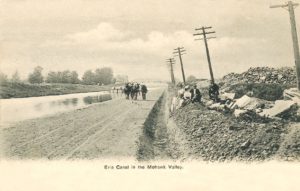Mohawk Valley history: May 1, 1902
The Utica Observer, May 1, 1902, Utica, Oneida County, New York
Straightening the Mohawk River
HOW IT WAS DONE 62 YEARS AGO NEAR HERKIMER.
Interesting Account Written by One Who Worked Upon the Job at the Age of 16–No Steam Shovels in Those Days.
To the Editor of the Observer:
The project of straightening the Mohawk River at Utica brings to mind when the river was a helper in changing the course of the old Mohawk near Herkimer. When the Erie Canal was enlarged in 1840 it became necessary to change the course of the stream farther north across the flats, the canal to take the place of the old river bed. The distance was about one-quarter of a mile commencing at the sharp turn about sixty rods below the bridge, between Herkimer and Mohawk.
My father being a sub-contractor, his two youngest boys were engaged in the work. My age was 16 and my brother 14. In those days work commenced at sunrise and ended at sunset–long days for lads of this age–to be called at 4 o’clock in the morning during the long days of the summer months to the hard labor with teams and dumping wagons. All the excavation was removed to form the wide embankment between the canal and new channel by teaming and wheelbarrows. In those days there were no appliances for removing earth as at present. As it was State work it was let by contract to a firm by the name of Frank & Elwood. All the shovelers in the work were Irishmen.
When the channel was completed the new embankment was faced by a rip-rap wall of hard head stone, for the protection against water wear. The largest that could be had and handled on wagons were the first to be rolled off of the embankment as a bottom course, and diminished in size to the top, where they may be seen to-day intact, as they were deposited sixty-two years ago. To get the desired stone a large extent of territory was gleaned.
At the present time this artificial piece of the Mohawk is a shallow rift. The bank the entire length is paved with gravel and stone. As the earth is alluvial soil like all the Mohawk flats (free of stone), it would seem a mystery that they should be deposited in this fast running water. It may be explained that the were in the strata…just below the depth of the excavation made, as the engineers had calculated the flow of water would take some of the excavating to the depth of the old river bed–which did not take it as expected. In consequence of this no down, much of the volume of water was dammed at the point…
…Years ago during the season of rainwater very little trouble was experienced by the overflow of the flats. There were no dyke or flood bridges…and the road was no higher than the ground on each side still there was…interruption in travel.
Many of the present inhabitants of Herkimer and vicinity no doubt are not aware that this change was ever made and the course of the Mohawk River just east of the Herkimer County fairgrounds. – A. L. Howell.
Source: NYSHistoricnewspapers.org


![Detroit Publishing Co., Publisher, photographer by Jackson, William Henry. Erie Canal at Little Falls. [Between 1880 and 1897] Photograph. Retrieved from the Library of Congress, <www.loc.gov/item/2016817495/>. Detroit Publishing Co., Publisher, photographer by Jackson, William Henry. Erie Canal at Little Falls. [Between 1880 and 1897] Photograph. Retrieved from the Library of Congress, .](https://mohawkvalleymuseums.us/wp-content/uploads/2024/05/IMG_4003.jpeg)











![Detroit Publishing Co., Publisher. Erie Canal, Utica, N.Y. [Between 1900 and 1915] Photograph. Retrieved from the Library of Congress, <www.loc.gov/item/2016810887/>. Detroit Publishing Co., Publisher. Erie Canal, Utica, N.Y. [Between 1900 and 1915] Photograph. Retrieved from the Library of Congress, .](https://mohawkvalleymuseums.us/wp-content/uploads/2024/03/IMG_3599-705x561.jpeg)

 Photo courtesy of the Fenimore Art Museum.
Photo courtesy of the Fenimore Art Museum.